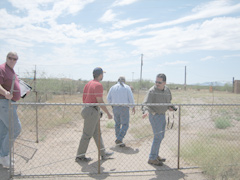Contact Pacific Southwest Waste Program
Pacific Southwest, Region 9
Serving: Arizona, California, Hawaii, Nevada, Pacific Islands, Tribal Nations
Leaking Underground Storage Tanks in Indian Country

Tribal & EPA representatives doing an initial site investigation on Tohono O'Odham Nation as part of the site inventory prior to the 2005.
Use of Federal LUST Trust Fund
EPA outlined special procedures for using the LUST Trust Fund for cleanups in Indian Country.
The Trust Fund can be used to address sites on State land only in rare cases, when the threat is a clear emergency (as part of EPA's Emergency Response program). More information »
History
The problem of leaking underground storage tanks in Indian Country was first noted by EPA's compliance and enforcement staff, who had been inspecting gas stations in Indian Country since the early 1990's. The EPA presence established by the UST inspectors helped the subsequent collaboration between EPA and the Tribes to address the LUST problem.
In the late 1990s, EPA teamed up with tribal programs to create an inventory of abandoned UST sites that could potentially be leaking. By 2005, over 230 potential LUST sites in EPA's Pacific Southwest region had been discovered.
Many of the gas stations that require cleanup were abandoned by private parties who are now either deceased or struggling to make a living themselves. These individuals could not afford to operate the gas station or pay for the cleanup, which often cost over $100,000, and can exceed $1 million in more serious cases.
The Tribes and EPA developed a process for using the Federal LUST Trust Fund for LUST cleanups in Indian Country. A 2005 EPA Headquarters Memorandum authorized the process, making the following Indian Country sites eligible.
- Abandoned USTs located on land for which leases had been negotiated by the Federal Government, and for which Tribes should not be held responsible.
- Leaking USTs that pose an immediate threat to the environment and nearby communities' health, and therefore require prompt action from the Federal Government.
The Memorandum enabled EPA to help Tribal communities that lacked the necessary resources to address the environmental risks of the abandoned and/or leaking USTs.
